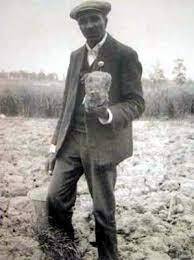George Washington Carver wasn’t necessarily known as a gardener but rather an agricultural scientist.
Carver was born in Missouri before slavery’s abolishment in 1865 and was owned (it’s weird writing that) by Moses Carver along with the rest of his family. Shortly after his birth, there was a raid in which his family was abducted. Moses Carver was able to find George but not the rest of the family, so Carver was technically raised by his master. Being enslaved meant he didn’t have a full name and upon entering school he gave the name “Carver’s George” and it would evolve to George Carver.
By 1886 he became a farmer in Kansas but within a couple of years, he was able to secure a loan from a nearby bank to attend college in Iowa while there a teacher urged him to study botany and began studying at Iowa State Agricultural College.
After earning a master’s degree he was invited to Tuskegee Institute and while teaching and researching, developed what looks like what we know as a Master Gardener program. His program like today’s Master Gardeners had university education/information provided directly to farmers via a traveling classroom by horse-drawn wagon.
Although brilliant, he wasn’t so good with administrative work while at the Tuskegee Institute. On top of that, a few people took issue with Carver being paid more, provided better accommodations, etc. Toward the end of his time at the school, it seems when a complaint or correction was directed his way, Carver would sometimes throw out something similar to “So, you want me to quit then?” No one really called his bluff, so he used that trick in response to everything from being called out for buying overpriced equipment to teaching assignments he didn’t want. Carver became the king of empty threats, but you got to admire it a little since it worked most of the time.
Despite his poor office skills and fake resignations, Carver left a significant impact on the world by developing techniques to improve depleted soils, finding organic and thrifty alternatives to expensive fertilizers, and researching crops such as peanuts (of course), soybeans, and sweet potatoes.
It’s a myth that Carver created peanut butter, however, he did create over 300 peanuts products including things like home insulation, paper, and shaving cream. What he did had a lasting impact on more than the peanut. He doesn’t always get credit for his educational outreach which helped improve the economic status of poor farmers in rural areas, especially in the South. Nor does he get the credit due for taking his educational outreach in his later years to struggling countries.

Images: Public Domain George Washington Carver c1910, 1942
Sources: Abrams, Dennis; Adair, Gene (2008). George Washington Carver: Scientist and Educator. Infobase Publishing
Kremer, Gary, ed. (2017). George Washington Carver: In His Own Words, Second Edition. Columbia, MO: University of Missouri Press.
Booker T. Washington, 1856–1915 My Larger Education: Being Chapters from My Experience, 1911. Documenting the American South
Raleigh Howard Merritt. From Captivity to Fame or The Life of George Washington Carver.
Linda O. McMurry (1981). George Washington Carver: Scientist and Symbol. Oxford University Press
Carver, George Washington; Kremer, Gary R. (ed.) George Washington Carver in his own words. University of Missouri Press. February 1, 1991
Smith, Andrew F. 2002. Peanuts: The Illustrious History of the Goober Pea. Chicago: University of Illinois Press.